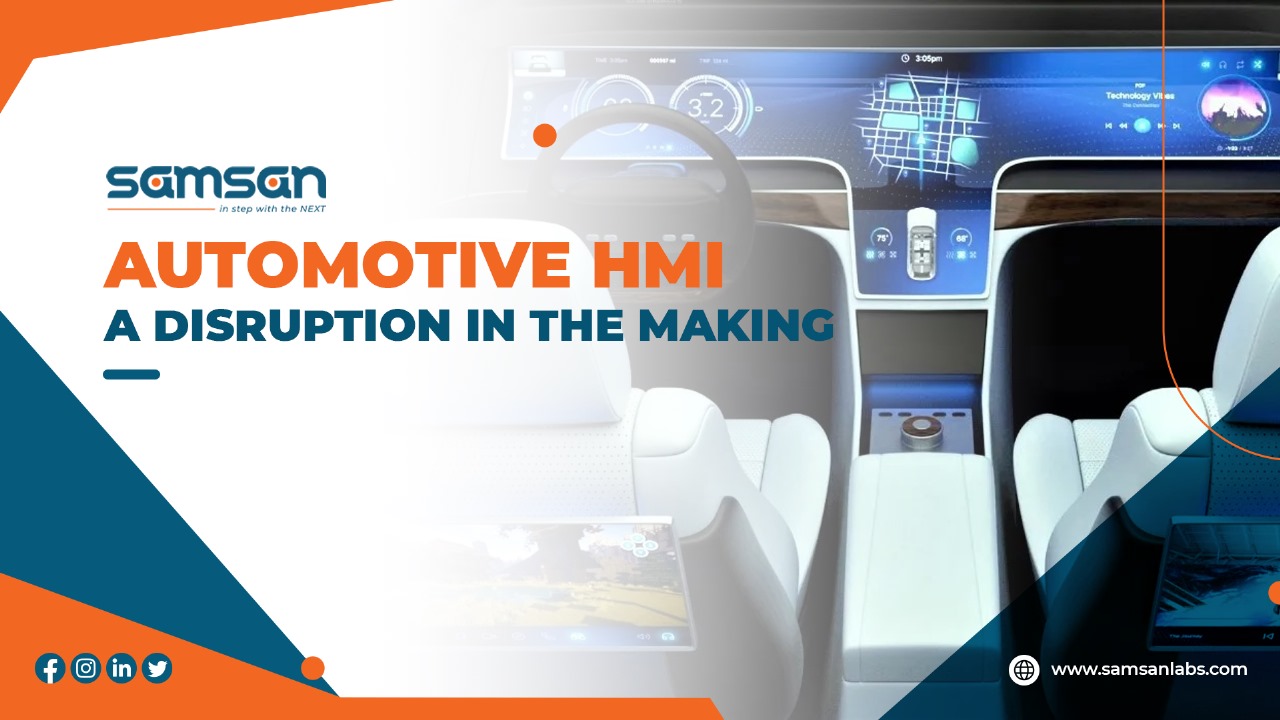In today’s fast-paced world, the automotive industry is constantly evolving to meet the demands of modern drivers. One pivotal advancement that has transformed the driving experience is the implementation of Human-Machine Interface (HMI) technology in modern cars. HMI is not just a fancy feature; it’s a game-changer that bridges the gap between drivers and their vehicles, enhancing safety, convenience, and overall driving satisfaction.
Picture this: You’re behind the wheel of your car, effortlessly controlling everything from navigation to entertainment with a simple touch or voice command. That’s HMI at work, folks! But there’s more to this story than meets the eye.
At SAMSAN Technische Labs, we are always looking at innovations that can be implemented in various business verticals. In this blog, let us find out the role of HMI in modern cars.
The Evolution of HMI in the Automotive Industry
Augmented Reality (AR): A Visionary Leap
Unlike virtual reality (VR) systems that require additional equipment, augmented reality (AR) seamlessly integrates into a driver’s daily activities. AR development has led to compact, unobtrusive technology that effortlessly melds with a driver’s routine. Head-up displays (HUDs) are a prime example, providing essential operational and directional information without necessitating a diversion of attention from the road.
Ongoing research into full-windshield virtual reality screens promises to revolutionize how vehicles alert drivers to dangers and provide easy access to directions or point-of-interest recognition. When this technology becomes widely available, it will have a significant impact on how vehicles warn drivers about dangers and provide easy access to directions or point-of-interest recognition. For instance, if an electric vehicle’s battery is running low, the nearest charging station might be visible to the driver, offering a seamless and intuitive solution.
Safety-First Strategy
While every aspect of automotive HMI advancements contributes to safety, advanced driver-assist systems (ADAS) represent a pivotal element. Recent developments have expanded the driver’s ability to understand emotions other than visual signals. It has been noted that tactile or auditory signals are processed more rapidly in high-stress situations, making them valuable tools in accident prevention.
Safety-oriented devices like steering wheel sensations or auditory alerts combined with warning indicators hold the potential to prevent accidents. ADAS HMI systems, equipped with an array of sensors and cameras distributed throughout a vehicle, have one overarching objective: to save lives.
No-Distraction Usage
As automakers move closer to implementing automated driving, the development of HMI systems, and the companies providing tailored vehicle HMI development services, becomes paramount. Currently, only a small percentage of vehicles employ countermeasures against distracted driving.
Driver tracking devices have emerged as a focal point for ensuring driver focus on their role as active participants behind the wheel. In-car cameras from major manufacturers like General Motors, Tesla, Subaru, Ford, and Toyota monitor driver alertness, issuing warnings if distraction is detected or suggesting breaks if drowsiness is apparent.
Enhanced Drawing Efficiency
The demand for feature-rich, contemporary-looking automotive HMIs is surging, but to create more complex visuals, graphical algorithms must evolve. Consumers now anticipate 3D graphics on par with video games in their vehicles. Utilizing appropriate design tools to craft intricate 3D and AR interfaces is critical.
Moreover, leveraging existing graphical APIs like Vulkan allows for the generation of high-quality, high-performance visuals on car System-on-Chips (SoCs). While discussions on customizing the driving experience abound, few products on the market truly enable it.
Personalization remains a challenge, as many current HMIs only offer limited customization options. While users may have the option to modify preset settings, few actually do so, resulting in suboptimal customization. Tailoring HMI design to align with consumer preferences can significantly enhance the driving experience.
Conclusion
In conclusion, Human-Machine Interface (HMI) in modern vehicles is undergoing a technological renaissance, with speech recognition, augmented reality, safety-focused features, and efficient graphical algorithms at the forefront. The road ahead promises even more remarkable innovations in automotive HMI, reshaping how drivers interact with their vehicles and the world around them.
SAMSAN Technische Labs is dedicated to staying at the forefront of these HMI advancements. We are committed to harnessing the power of technology to enhance safety, convenience, and personalization for every driver. As the automotive industry continues to evolve, our mission remains unchanged – to provide you with the most sophisticated and user-friendly HMI solutions for your driving pleasure. We invite you to join us on this exciting journey into the future of automotive HMI technology, where innovation meets engineering, and the road ahead is paved with limitless possibilities.

